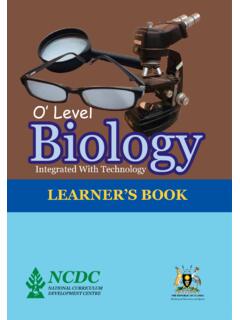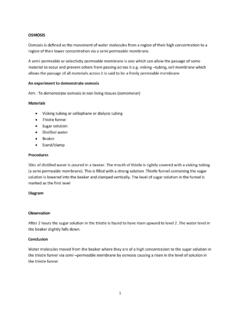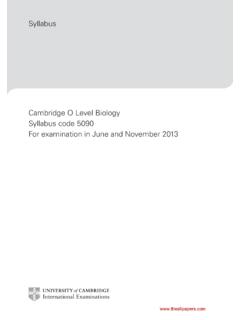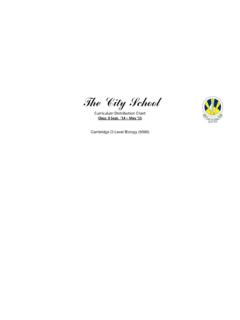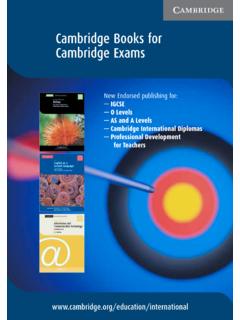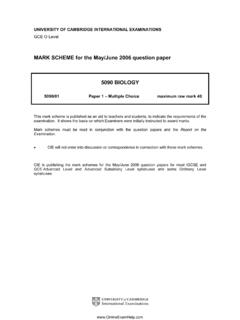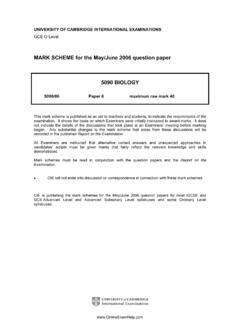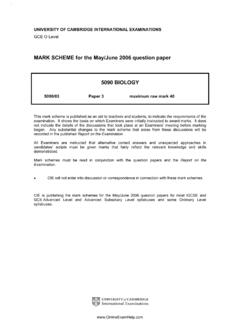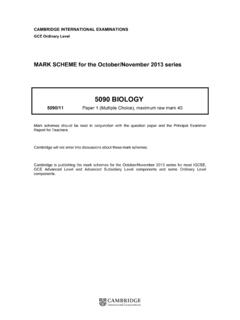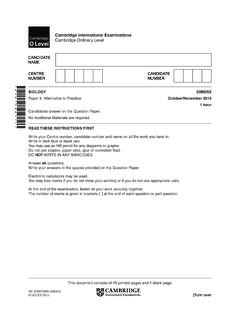Transcription of O’ Level Biology - Gayaza High School
1 ALEARNER S BOOKM inistry of Education and SportsO LevelBiologyIntegrated With TechnologyLEARNER S BOOKM inistry of Education and SportsBiologyIntegrated With TechnologyO LevelCopyright National Curriculum Development Centre, Uganda, 2012 Published byNational Curriculum Development Centre (NCDC), Box 7002, Kyambogo, rights reserved. No part of this publication should be reproduced stored in a retrieval system or transmitted in any form by any means electronic, mechanical, photocopying, recording or otherwise without the permission of the publisher. No patent liability is assumed with respect to the use of the information contained : 978-9970-00-091-3 Website: iForeword iiPreface iiiAcknowledgement ivIntroduction vChapter 1: DIVERSITY OF LIVING THINGS 1 Chapter 2: SOIL 67 Chapter 3: NUTRITION IN ORGANISMS 85 Chapter 4: TRANSPORT IN PLANTS AND ANIMALS 131 Chapter 5: GASEOUS EXCHANGE AND RESPIRATION 151 Chapter 6: HOMEOSTASIS AND EXCRETION 181 Chapter 7: COORDINATION IN PLANTS AND ANIMALS 199 Chapter 8: LOCOMOTION 213 Chapter 9.
2 GROWTH AND DEVELOPMENT 219 Chapter 10: REPRODUCTION IN ORGANISMS 229 Chapter 11: GENETICS AND ENVOLUTION 257 Chapter 12: INTERRELATIONSHIPS 269 BackgroundThis Learners Handbook contains information on Biology Integrated with Technology activities related to topics in the UCE Biology Curricu-lum. The practical activities in this Handbook provide an economical product or provide a service. Comparing it to a number of Biology text-books, that have the conventional practical activities, most of which are done in School laboratories, do not directly relate to everyday life should be appreciated that Science and Mathematics are key learn-ing aspects that play a vital part in our lifestyle. At home, within a community, national and internationally learners meet with Sci-ence and Mathematics functional knowledge.
3 Therefore, the need to broaden an understanding and skill development is of paramount importance for sustainable find it easier to carry out scientific and Mathematics activities outside the classroom for example making garments, bread, alcohol, ice cream and furniture. All these activities are directly related to what is learnt in Sciences and Mathematics at School but no refer-ence to them is done thus making these subjects abstract and less interesting. This is to appeal to the users of this book to avoid ne-glecting innovations that guide learning but embrace all the Science/ Mathematics concepts in the major reason for undertaking this new approach to teaching-learning Sciences and Mathematics at O Level is to improve the academic achievements and interest of idea of integrating Technology into Sciences and Mathematics at lower secondary education was conceived after realizing that Science and Mathematics teaching at this Level hardly generated interest in the learners.
4 In addition, these learners were lacking in practical skills and rarely applied Science and Mathematics to everyday life situations. The National Curriculum Development Centre (NCDC) has developed this new approach of teaching Science and Mathematics by including practical activities that enable learners to come up with products or be able to offer services to the community leading to national sustainable development by generating their own book was developed and prepared in a series of writing and discussion workshops organised by the National Curriculum Development (NCDC) between 2007 and wish to acknowledge the contribution of the subject panel members, teachers and learners from various schools who participated at trial activity phase and other education stakeholders that provided input and direction of this am grateful to all those who worked behind the scenes for the commitment in ensuring the work is done and feedback from the field is incorporated.
5 I also thank the African Development Bank (ADB) Project Phase-III for the financial but not least, I wish to recognise agencies, companies and websites for the reference materials and pictures used in this KateebaDirector NCDCivINTRODUCTIONvIntroduction The idea of integrating Biology with Technology is a result of efforts to improve performance and developing an interest in the Biology teaching-learning process. It involves integrating the Biology concepts taught into real-life experiences. The integration of the principles of Biology with Technology encourages the application of theoretical knowledge to sustainable economic development. It aims at providing information and knowledge to learners that can be used to develop competences that can result in the provision of a service and/or a commercial product.
6 Entrepreneurial skills are integrated with biological concepts with a view to achieving academic excellence and economic development. RationaleThe purpose of developing a learner s book which integrates Biology with Technology is to guide the teaching-learning process towards academic achievement by applying the knowledge acquired in a classroom setting to real-life experience. Learners should develop the ability to use abstract knowledge or concepts to develop a commercial product or provide a service with a view to improving the standard of living and achieving sustainable of the Learner s HandbookThis handbook is intended for learners of Biology at Ordinary Level of education. It will help to enhance the implementation of the Biology subject principles to everyday life experiences.
7 The benefits of integrating Technology into Biology are to, among others: generate interest in the teaching-learning process, through the application of acquired scientific knowledge to new situations and vieconomic development. encourage the use of challenging tasks to discover knowledge/information, develop skills of innovativeness (creativity), and interactivity in addition to critical thinking competences. acquire skills for providing services and making products for consumption and sale. attain academic learner, therefore, is expected to transfer the knowledge acquired or relate academic concepts to everyday life by becoming innovative and improving the quality of life in the to Use this Handbook This handbook is meant to be used together with the class notes or the Biology syllabus.
8 In order to understand the concepts contained in this book, you should have prior knowledge of Biology which you will relate to the given activities. The handbook includes: Guidelines on Biology integrated with Technology concepts, in which an economic activity is indicated or may be developed. Competences that you the learner should develop when carrying out the activities. Follow-up activities to enhance further learning of the Biology concepts or how you can apply the knowledge attained in other areas or similar to learn Biology integrated with Technology should have a positive influence on the teaching-learning process through enabling the learner to: develop an interest in learning biological principles and understanding the significance of concepts to everyday understand ways in which human beings influence the natural trends in the environment and communities for economic development.
9 Apply the Biology knowledge further in day to day life phenomeno. recognise the use of biological concepts to solve problems and improve standards of living. communicate accurate biological facts for sustainable education and development. design and develop procedures for carrying out investigations related to the community values and economic development. develop the ability to interpret data and write logical, precise and clear reports leading to the production of a product or service of value in our day-to-day lives. use available resources, local materials and facilities to carry out project work/research to obtain information that improves the quality of community life. relate various concepts and explain their relationship to phenomena in the environment.
10 Harmonise scientific information with prior experiences in order to predict the future impact on everyday i) Continuous assessmentIt is recommended that the teacher carries out continuous assessment basing on concepts/topics, through tests, quizzes, assignments, concept paper presentations in seminars, projects, experimental activities, etc. The assessment should reflect the acquisition of the following testable competences or learning outcomes:a) Knowledge of: principles and generalisation identified in the syllabus. trends and sequences of phenomena. classification and investigation, procedures and techniques or methods. conventions and accurate presentation of facts. ways and means of defining terms and ) Comprehension ability to: translate facts and communicate knowledge accurately in correct language.
